Last Updated on April 21, 2020
Looking for a motorcycle gear 101? Whether you don’t know where to start or if you’re wanting to learn the most you can about gear, we’ve got you covered.
There is a lot that you need to understand about gear before you buy gear.
How to tell if it’s going to be protective, how to be certain that a specific piece of gear is going to fit or what to expect when you’re out there looking for gear – it’s all here with this motorcycle gear 101 post.
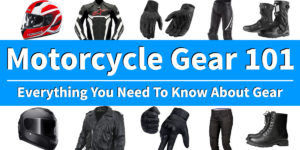
Motorcycle Gear 101
Helmet, jacket, pants, gloves and boots. Motorcycle gear has proven over and over again that wearing gear can and most likely will save your life in the event of an accident.
That’s why gear was made. Sure, certain pieces of gear will make you sweat more and if you don’t know what to look for then you’ll find gear that is extremely uncomfortable in the long haul as well.
You need to know what to look out for when it comes to motorcycle gear that way you’re fully prepared before and during your rides.
Our hope is that this post will shed the light you need when it comes to finding proper motorcycle gear that’s right for you!
Why Should You Wear Gear?
There are plenty of individuals who believe in the saying of…
“If you get into an accident, nothing is going to help anyway.”
Or my personal favorite is…
“A helmet is just a brain scoop for the paramedics when you get into an accident.”
If you fall into those types of beliefs then I encourage you to look into reasons to not wear a motorcycle helmet and to go ahead and check out before/after pictures & videos of real life accidents with gear on and without gear on… You’ll see a massive difference and you’ll see why gear is important.
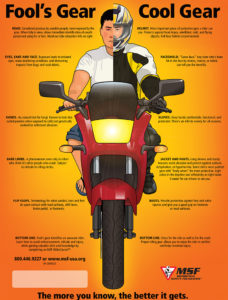
There is plenty of material out there that you should read through, especially from the Motorcycle Safety Foundation that way you can get a clear understanding how much gear helps in every situation.
A great source of information can be read through MSF Cycle Safety Information – we highly recommend reading through it as it’s a major source of the information that we share here as well.
It doesn’t matter if you’re on a 50cc moped or an 800cc motorcycle… You should always wear gear no matter what. You never know what could happen and you’ll be thanking yourself 100 times over if you were to ever get into an accident and you had the proper gear on during it.
But you also need to make sure that it’s the right gear. There is a lot of stylish gear out there but is it going to actually protect you? What about ventilation?
Are you riding in the super hot Arizona heat or is it a cooler area that you’re in?
What kind of gear suits you best for where you’re mostly riding?
Are you mainly commuting to work in city streets or are you constantly on the interstate?
You’ll need to answer all of those types of questions for yourself before you get into finalizing a purchase on any piece of gear. For example, different types of jackets will serve their purpose of keeping you warm or if it’s able to breathe while also still being to protect you.
What Does Good Gear Have?
A stylish leather jacket you find at a local leather store isn’t going to cut it. Shoes are most likely going to fly off of your feet or the laces could get tangled on your rear brake or gear shifter.
Regular jeans will rip and tear within seconds of sliding on the concrete and your long sleeved sweatshirt isn’t going to have any impact protection whatsoever.
Let’s go ahead and look at each type of gear individually and look at what to look for when it comes to maximum protection and usability.
Helmets
There are four parts of a helmet when it comes to the overall protection of the helmet.
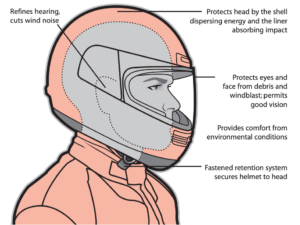
The outer shell, an impact-absorbing liner, padding for comfort and the chin strap.
An outer shell is usually made out of a combination of materials such as fiber-reinforced composites or thermoplastics like polycarbonate.
These materials are extremely strong materials that are specifically designed to handle crazy impacts by compressing on moments of impact which significantly reduces the amount of force to your head when you bash it against the asphalt.
The inside of the shell is also made specifically for reducing force on impact which is the impact absorbing liner.
These are usually made out of expanded polystyrene which is essentially styrofoam. The liner layer absorbs more of the shock when the helmet is being slammed against the ground.
Padding inside of the helmet itself is created mainly with cloth and foam. It can usually be taken out to clean it up which we recommend doing, especially if you’re constantly sweating while riding. Padding is used to ensure comfortability while wearing the helmet.
Chin straps are what keep the helmet on your head when you’re in an accident – which makes it a tremendously important part of the helmet. You’ll always want to make sure you’re tightening the strap to a snug amount and you’ll want to make sure that the strap is made of materials that aren’t easy to break.
Full-face helmets absolutely provide the maximum amount of protection when it comes to helmets. To be sure that whatever helmet it is that you’re interested in will do a good job of protecting you make sure that it has passed specific standards.
In the US, the DOT standard is what you’ll mainly want to look for. However, if a helmet has passed a Snell standard then you can know that it has gone a bit of an extra mile in terms of impact testing.
Don’t forget to look into ventilation features of each helmet as you browse around for what you want. Air vents at the top, front and sides help a lot with air flow through the helmet. Different types of padding used for the inside can be good for negating sweat as well – it depends on the type of padding used.
Jackets
Jackets that are able to protect you to the highest degree would include having portions of the jacket have abrasion-resistant materials such as leather, Cordura, Kevlar or ballistic nylon.
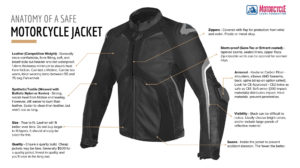
Leather should be self-explanatory when it comes to why it’s more protective than say a cloth sweatshirt. Leather is a durable, tough material that has been proven over and over again to be resistant to abrasions or tearing in the event of an accident.
Cordura fabrics are specifically designed for durability and resistance to scuffs/tearing. It’s a lot like Kevlar but it’s not as heat-resistant so you’ll see Cordura fabrics for other uses other than motorcycle jackets but it is still used from time-to-time.
Kevlar is used in some armor padding when it comes to jackets. Definitely look to see if certain jackets are using Kevlar or Cordura type fabrics but understand that it’s also not essential when it comes to purchasing a jacket.
You’ll mainly be looking for CE approved armor labels when you’re looking at getting any ideal jacket. Then take a look at where the padding is at on the jacket and make sure that the armor padding would actually be in good spots in the event of a crash.
You’ll want to have padding for your spine, elbows, outer forearms, shoulders and the front if you want some of the most impact protection possible with your jacket.
You should also keep in mind of the ventilation and overall breathability of the jacket, especially if you’re in hotter weather most of the time.
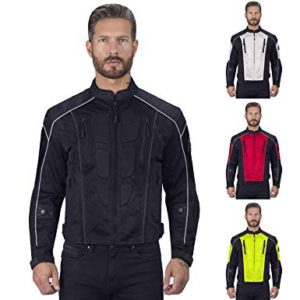
Mesh jackets with an optional inner-liner are almost always a path of least resistance.
The liner provides extra warmth but if you’re able to take it out you still have protection within the jacket and since it’d be mesh material air would flow more easily through the jacket.
If riding in colder weather is what you’ll be doing most and want to be prepared for then there are jackets and rain suits specifically designed for that.
Insulated suits and rain motorcycle gear is what you’ll want to look out for if you know you’re going to be in cold, windy and rainy weather.
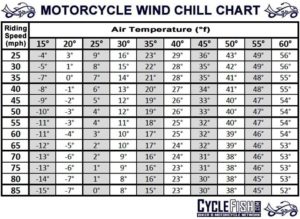
As for comfortability and making sure the jacket is right for you – it should feel snug but not to the point where you feel like to might tear the seams from moving your arms around. It needs to be tighter but not so tight that you have a chance of ripping the jacket.
Whichever jacket you fancy, make sure it has good impact resistant armor ratings and that it fits correctly.
Wrists should be snug, you should be able to move your arms around freely without feeling loose and it should always feel like you have that extra protection going on.
When it comes to jackets, you need to know what to look for before you come to any sort of final buying decision. You’ll likely have the jacket for a good while before deciding on another since they aren’t cheap.
Gloves
There are plenty of different styles of gloves that are available on the market. Full-fingered motorcycle gloves protect you the most from things such as cuts, bruises, blisters, abrasions, harsh winds, sun waves and cold weather.
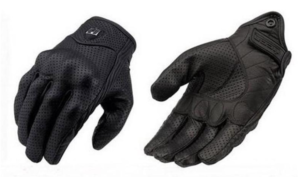
Your best bet when it comes to riding gloves would be to make sure that they have leather undersides for your palm and fingers. This is essential because if we ever get into a wreck and fall off of the motorcycle our first instinct is going to be to brace ourselves with our hands.
By wearing gloves that have a leather underside you’ll be able to significantly reduce the damage done to your hands due to leather being the tough material that it is.
Most motorcycle gloves will also have D30 or other highly rated types of armor for your knuckles. Knuckle armor can be made from polymer, alloy steel, TPU, D30 or other hard materials proven to help with impact and abrasions.
Depending on where you live and ride most, you may want to have two pairs of riding gloves. If you’re in hotter climates then you’ll want lightweight, mesh gloves with leather on the underside. If you’re in colder weather then you’ll want heavyweight, thicker gloves that have multiple layers to keep you warm.
Not just any leather glove or work glove will do. You need to make sure that the gloves you get are designed specifically for riding motorcycles since they go through all of the tests and what not to make sure that the gloves are worth wearing in the event of a crash.
Make sure that the gloves feel snug and that they won’t fall off while also making sure that they wouldn’t roll into your palm on your grips or feel too tight.
Pants
Kevlar padding is the most common type of riding pants that you’ll find on the market. When you’re looking into riding pants make sure that it has been proven through testing to back up the claims of being resistant to abrasions and impact.
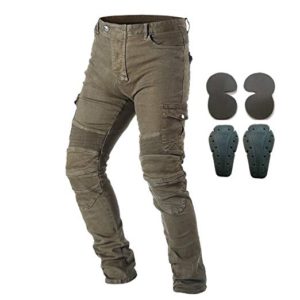
Regular jeans will tear open almost immediately within contact of the ground in an accident. Regular denim doesn’t cut it which is why riding pants is so important.
Pants are often the most looked over piece of gear because of that reason. Most riders think that their normal jeans will be just fine but it absolutely will not be enough.
Riding pants can vary on material from polyester, leather, Kevlar fiber and tough denim.
When you’re on the lookout for riding pants that are going to last a long time and help you the most in a wreck then you should look for good armor rating padding on the knees and hips as well as seeing if the pants are double-stitched and tested for abrasion resistance.
Sizing works basically the same as you would with any regular jeans or pants. Some pants will be sized based on S, M, L and etc. – so be sure to check into the sizing charts for different types of pants if they have them.
Be sure to look into overall comfortability and flexibility on the pants as well. It’s nice to have super protective pants but it’s not nice at all when you can hardly move your legs around due to crazy, tight stitching.
If you’re going to be getting pants then be sure not to cheap out and make sure you do your research on each specific pair. Padding, comfort, stitching and materials used. Once you know all of that then you’ll know which pair of pants is right for you.
Boots

Riding boots are another overlooked part of a rider’s gear set.
Running shoes or skate shoes aren’t going to help your feet at all in an accident.
Those types of shoes are going to fly off immediately and you’ll be having inevitable abrasions and rashes because you didn’t have riding boots on.
Look, I get it… you want to have cool shoes on while riding to look good.
Although you shouldn’t worry about how you look while riding since safety should be the focus, there are plenty of really cool styles of boots out there. There are some that even look like shoes.
Riding boots keep laces out of your rear break/gear shift, protect your ankles, they can prevent abrasions on your feet and they can significantly reduce impact damage.
Good boots will at the least go above your ankle but there are also boot styles that will fully cover your shins as well. The good ones will make it easy for laces to not be in the way of your break and gear shift while also being made out of tough material.
The point of wearing riding boots is to make sure that your feet and ankles are protected if you were to ever have to take a fall while riding. They are significantly safer than any type of regular shoe.
Purchasing Gear
Gear that is worth getting isn’t going to be cheap and you need to include gear in your budget before you even buy a motorcycle (for those of you that are new to riding).
But you also don’t have to get the absolute most expensive pieces of gear in order to be safe out there.
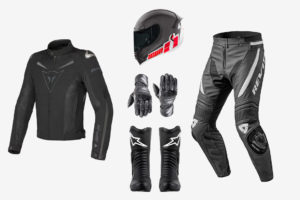
Helmets range anywhere from $50-$1,000+ but you’ll find great full-face helmets that function the way they should and that are comfortable around the $100-$200 range.
Jackets can be very expensive, especially when you’re strictly looking for a good style of jacket. Yeah, it’s nice to look “cool” out there but safety is much more important.
You’ll be able to find jackets that can breathe well, keep you warm and have the proper armor for around $80-$200 depending on what you’re looking for.
Pants are probably the most uncommon piece of gear but they’re one of the most important pieces as well. Cheap riding pants can be exactly like regular jeans which get torn immediately as if you’re trying to wear a sheet of paper as protection.
Most riding pants will cost around the $100 range though they can also be more expensive if you’re looking for a ton of extra features and maximum protection on them
There are plenty of different riding glove brands out there and you should always be looking for gloves that at least have leather on the palms and that have armor for the knuckles. You’ll find leather gloves with armor for around $30-$80 depending on what features are best for you and your riding style.
If you are on a tight budget when it comes to riding gloves then be sure to check out our cheap riding gloves guide before you make a final decision on a pair. We showcased a lot of different glove choices that are easier on your wallet.
Boots are extremely helpful as good riding boots will keep laces away while also having a thick layer of leather and armor around your ankle. You should always ride with a pair of shoes/boots that go above your ankle and protect your feet all the same.
Good boots are going to be around the $100 range – even more if you’re looking at the more expensive, stylish ones.
You also need to know the best places to buy motorcycle gear online but maybe you’ve also got some local shops around you to give you an idea of different helmet and jacket sizes that would suit you.
All in all, you should be ready to spend $500+ if you’re buying every piece of gear which is what you should do. Anything could happen while you are out there riding, even if you think you’re the most skilled rider.
How To Know If The Gear Fits Right
Simply try them on and see what it feels like! If you’re strictly getting your gear online for the good deals then there should be sizing charts for every kind of gear where you’ll be able to tell if it’s going to fit or not.
You should also take note of any online or local shop’s return policies if something were to not feel right or not fit right. Don’t settle for something because you don’t want to take the time to make a return or something because in the end it isn’t going to be worth doing.
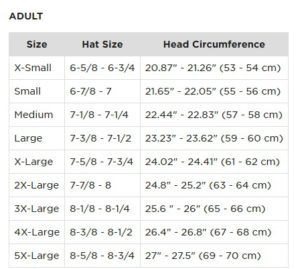
For an example of fitting from me personally, I am about 5’11 and I weight about 190 lbs. I went ahead and ordered a large sized jacket and it is the perfect fit for my body type. I went off of the US sizing chart that was recommended to go off of from the purchase page and went with it.
Helmet sizes are a bit odd to be able to tell if something is going to fit or not. I’d recommend heading to a local shop and trying on different sizes to see what feels right.
When it comes to helmets, you should be able to bite your teeth down without biting your cheeks, you shouldn’t be able to move the helmet too much left or right while it’s on and it should feel snug after tightening the chin strap.
As far as gloves, I wear a large sized glove and it is the right fit. For the most part, it’ll be about the same type of sizing as winter gloves or any other type of glove.
Pants usually go off of regular sizing for waist and length as you would when trying to buy normal jeans. Boots, depending on the style, are also usually sized the same way as regular shoe sizes.
Most shops will have a nice return policy so you shouldn’t be afraid to order something and at least try it out. You are best off trying gear on at a local shop as most shops don’t mind when there are people trying on the different gear.
Do Your Research
This concludes our motorcycle gear 101 – we’ve done most of the research for you but there are plenty of other posts here within the site as well as reviews and what not to help you fully understand the gear before you go all in on it.
Hopefully this helped you understand what to look for when it comes to gear. Understanding what to look for is essential when you’re trying to get all of your riding gear together.
So, do you feel ready to find your perfect set of gear?
Which pieces of gear are you planning on getting for yourself?
Let us know in the comments below!

What’s up! I’m Colton, the main guy behind Moto Gear Knowledge. Gear has always been my #1 priority when it comes to riding.
I share my experiences regarding gear and anything else moto related with you here. 👍

Very insightful! I’m going to pin this page and use it as a study guide for my eventual motorcycle training course! Lots of great information and explanation for a beginner like me. Would be surprised if you weren’t an instructor.
Wow, thanks for the kind words man. I’m not an instructor, but I’m extremely passionate when it comes to maximizing safety when you’re on two wheels. You’ll need boots that cover your ankles and they always ask that you wear something with long sleeves and a full-face helmet… Might as well just have the gear ready to go while going through the motions of the training course at that point. Doesn’t hurt.
Then you’ll already be used to riding with the gear on and can move forward right after you get your riding license. 👍
Great article! Understanding the ins and outs of moto gear is important and you did a great job explaining everything man. Thank you
I’m glad you enjoyed the post! The goal was to help people either just starting to ride or starting to look into gear to have a better understanding. Glad it helped you out